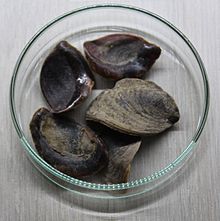

Onycha (/ˈɒnɪkə/, Ancient Greek: ὄνυξ, romanized: ónux), along with equal parts of stacte, galbanum, and frankincense, was one of the components of the consecrated Ketoret (incense) which appears in the Torah book of Exodus (Ex.30:34-36) and was used in Solomon's Temple in Jerusalem. This formula was to be incorporated as an incense, and was not to be duplicated for non-sacred use.[1] What the onycha of antiquity actually was cannot be determined with certainty. The original Hebrew word used for this component of the ketoret was שחלת, shecheleth, which means "to roar; as a lion (from his characteristic roar)" or “peeling off by concussion of sound."[2] Shecheleth is related to the Syriac shehelta which is translated as “a tear, distillation, or exudation.”[3] In Aramaic, the root SHCHL signifies “retrieve.”[3] When the Torah was translated into Greek (the Septuagint version) the Greek word “onycha” ονυξ, which means "fingernail" or "claw," was substituted for shecheleth.